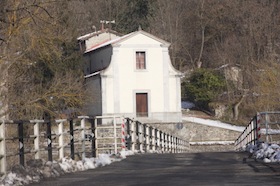-

THE CHAPEL OF MADONNA DEL BOSCO

- The Chapel of Madonna del Bosco, or Our Lady of the Wood, was built in the early seventeenth century along one of the oldest Apennine passageways; its function was probably that of a “Hostel” where travellers could rest and find refreshment. The origins of the sanctuary can be traced back to a precise date: 1630, the year of the great plague that hit Italy. It is for this reason that the small sanctuary was dedicated to the Saints Sebastian and Rocco, protectors of this terrible curse. The original dedication gave way to a new devotion which was spread thanks to the works of Carmelite fathers in the late seventeenth century: worship of the Madonna del Monte Carmel, or Our Lady of Mount Carmel, also known as the Madonna del Carmine. This title was added to the original and then replaced it completely. The attribute “del Bosco”, or \"of the Wood” was later added to this title, which was kept for centuries, but there was also “Ridicanè” from the name of the brook that is still given this name. From the report by Cardinal Boncompagni upon his visit to the church in 1692 we learn that it was built, like most mountain chapels, “ad modum capannae” that is to say, with a pitched roof and a rectangular plan. A statue of the Madonna was worshipped here. Standing in a niche, with a silver crown, it was carried in a procession during the holiday on the 16th of July. Leaning against the Pliocene sandstones, Calindri reveals the presence of “two cramped cells, partially walled and partially dug into the stone” to be used by a hermit who looked after the chapel.